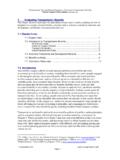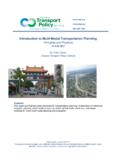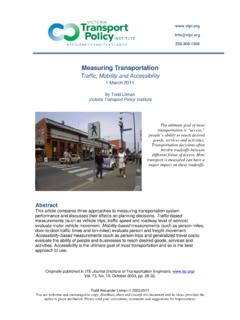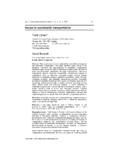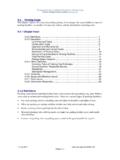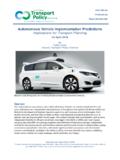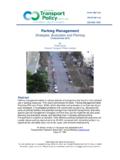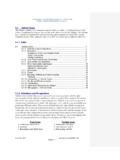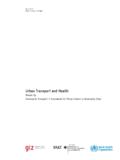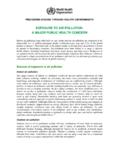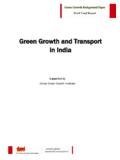Transcription of Evaluating Public Transportation Health Benefits - …
1 250-360-1560 Todd Litman 2010-2015 You are welcome and encouraged to copy, distribute, share and excerpt this document and its ideas, provided the author is given attribution. Please send your corrections, comments and suggestions for improvement. Evaluating Public Transportation Health Benefits 25 November 2016 Todd Litman Victoria transport Policy Institute For The American Public Transportation Association Abstract This report investigates ways that Public Transportation affects human Health , and ways to incorporate these impacts into transport policy and planning decisions. This research indicates that Public transit improvements and more transit oriented development can provide large but often overlooked Health Benefits . People who live or work in communities with high quality Public transport tend to drive significantly less and rely more on alternative modes (walking, cycling and Public transit) than they would in more automobile-oriented areas.
2 This reduces traffic crashes and pollution emissions, increases physical fitness and mental Health , and provides access to medical care and healthy food. These impacts are significant in magnitude compared with other planning objectives, but are often overlooked or undervalued in conventional transport planning. Various methods can be used to quantify and monetize (measure in monetary units) these impacts. This analysis indicates that improving Public transit can be one of the most cost effective ways to achieve Public Health objectives, and Public Health improvements are among the largest Benefits provided by high quality Public transit and transit-oriented development. Evaluating Public Transportation Health Benefits Victoria transport Policy Institute 1 Summary of Findings High quality Public Transportation (convenient, comfortable, fast rail and bus transport ) and transit oriented development (walkable, mixed-use communities located around transit stations) tend to affect travel activity in ways that provide large Health Benefits , including reduced traffic crashes and pollution emissions, increased physical fitness, improved mental Health , improved basic access to medical care and healthy food and increased affordability which reduces financial stress to lower-income households.
3 Traffic casualty rates tend to decline as Public transit travel increases in an area. Residents of transit-oriented communities have only about a quarter the per capita traffic fatality rate as residents of sprawled, automobile-dependent communities. Public transit reduces pollution emissions per passenger-mile, and transit-oriented development provides additional emission reductions by reducing per capita vehicle travel. Center for Disease Control recommends that adults average at least 22 daily minutes of moderate physical activity, such as brisk walking, to stay fit and healthy. Although less than half of American adults achieve this target, most Public Transportation passengers do exercise the recommended amount while walking to and from transit stations and stops. Neighborhood design features that support transit, such as walkability and mixed land use, also support Public Health . Of people with safe places to walk within ten minutes of home, 43% achieve physical activity targets, compared with just 27% of less walkable area residents.
4 The United States has relatively poor Health outcomes and high healthcare costs compared with peers, due in part to high per capita traffic fatality rates and diseases resulting from sedentary living. Public transit improvements can improve Health outcomes and reduce healthcare costs. Inadequate physical activity contributes to numerous Health problems, causing an estimated 200,000 annual deaths in the , and significantly increasing medical costs. Among physically able adults, average annual medical expenditures are 32% lower for those who achieve physical activity targets ($1,019 per year) than for those who are sedentary ($1,349 per year). Many physically and economically disadvantaged people depend on Public Transportation to access to medical services and obtain healthy, affordable food. Current demographic and economic trends (aging population, rising fuel prices, increasing Health and environmental concerns, and rising medical care costs) are increasing the value of Public Transportation Health Benefits .
5 A growing portion of households would prefer to drive less and rely more on walking, cycling and Public transit, provided these alternatives are convenient, comfortable, safe and affordable. Conventional planning tends to overlook and undervalue many Transportation -related Health impacts. More comprehensive evaluation can better integrate Transportation and Public Health planning objectives. When all impacts are considered, improving Public transit can be one of the most cost effective ways to achieve Public Health objectives, and Public Health improvements are among the largest Benefits provided by high quality Public transit and transit-oriented development. Evaluating Public Transportation Health Benefits Victoria transport Policy Institute 2 Introduction Live Long and Prosper Current Health trends offer both good and bad news. The good news is that many simple, affordable, and often enjoyable lifestyle habits can lead to healthier and happier lives: breath fresh air, avoid dangerous driving, maintain healthy weight, be physically active, eat fresh fruits and vegetables, maintain friendships, and avoid excessive stress.
6 Even chocolate is considered healthy if consumed in moderation! But there is also bad news. Many people find it difficult to maintain healthy habits. As a result, the has relatively poor Health outcomes compared with peer countries, and according to some projections average lifespans may actually decline in the future due to growing but avoidable Health risks. Major Avoidable Health Risks Unhealthy eating Overweight and obesity Sedentary living Pollution exposure Tobacco consumption Excessive alcohol consumption Drug abuse Traffic crashes Social isolation Stress and depression Suicide Homicide Transportation and land use planning decisions affect many of these Health risks. A growing body of research indicates that the quality of Public Transportation (also called Public transit, urban transport and rapid transit) in a community affects Public Health in many ways, including some impacts that are often overlooked or undervalued.
7 This report investigates these impacts and ways to better incorporate them into Transportation planning. This analysis can help transport and Health professionals better coordinate their efforts to create communities where people can live long and prosper (CDC 2010). Evaluating Public Transportation Health Benefits Victoria transport Policy Institute 3 Travel Impacts The quality of Public transit, and the degree it is integrated into a community, significantly affects travel activity. As service quality improves and communities become more transit-oriented, residents tend to own fewer vehicles, drive less and rely more on alternative modes (walking, cycling and Public transit) than they otherwise would (ICF 2008; Litman 2007). Table 1 Impacts on Vehicle Ownership and Travel (Ohland and Poticha 2006) Land Use Type Auto Ownership Daily VMT Mode Split Per Household Per Capita Auto Transit Walk Bike Other Good transit/Mixed use Good transit only Remainder of region Residents of transit-oriented neighborhoods tend to own significantly fewer motor vehicles, drive significantly less, and rely more on walking and Public transit than residents of other neighborhoods.
8 Table 1 and Figure 1 illustrate this pattern in Portland, Oregon, although similar effects occur in other cities. Residents of communities with high-quality, well integrated Public transit (called transit-oriented development or TOD), own half as many vehicles, drive half as many annual miles, walk and bicycle four times more, and use Public transit ten times more than residents of more automobile-dependent communities. These differences partly reflect self selection, the tendency of people who by necessity or preference rely on alternative modes to locate in transit-oriented areas, but that is generally a minor effect (Cervero 2007). A typical household that shifts from an automobile-dependent to a transit-oriented community drives significantly less and relies much more on alternative modes. Even residents who commute by automobile tend to reduce their annual vehicle mileage by shifting mode and reducing the distances of other trips (errands, recreation, children s travel to school, etc.)
9 Due to more accessible land use. Figure 1 TOD Impacts On Mode Split in Portland, Oregon (Ohland and Poticha 2006) People who live in transit-oriented communities tend to own fewer vehicles, drive less and rely more on alternative modes. Daily VMT indicates average daily vehicle miles traveled per capita. A New York City Department of Health study evaluated the Health Benefits of active Transportation . The results, summarized in Figure 2, indicate that people who commute by walking, cycling or Public transit Evaluating Public Transportation Health Benefits Victoria transport Policy Institute 4 achieve about twice the total ( Transportation and recreational) exercise as automobile commuters, and so are much more likely to achieve Public Health targets of thirty or more daily minutes of moderate physical activity. This study can be a model for use in other communities interested in tracking physical fitness and Health . Figure 2 Recreation And Transportation Exercise By Commute Mode (NYCDH 2011) 0102030405060708090 Walk/BikePublic TransportPersonal Car/TaxiAverage Daily MinutesRecreationActive transport Although the amount of time people spend in recreational physical activity (sports and Health club exercise) is similar for all commute groups, those who commute by walking, cycling and Public transit have much more active Transportation and so are much more likely to achieve the Public Health target of at least thirty daily minutes of physical activity.
10 Although this study was performed in New York, the results are similar to those found in other cities. Evaluating Public Transportation Health Benefits Victoria transport Policy Institute 5 Transportation Health Impacts This section evaluates the degree to which Transportation affects Public Health risks. Travel activity affects Public Health in several ways. Figure 3 indicates ways that travel activity affects the ten leading causes of Potential Years of Life Lost (PYLL, which takes into account age of death and therefore reflects the greater costs to society of risks to younger people). For example, pollution contributes to cancer and congenital anomalies (birth defects), and sedentary living (inadequate physical activity) contributes to heart disease and strokes. transport activity affects five of these Health risks, including the three largest, which cause more than 60% of total potential years of life lost. Figure 3 Ten Leading Causes of Potential Years of Life Lost (NCIPC 2009) 0500,0001,000,0001,500,0002,000,000 Liver DiseaseStrokesHIVC ongenit al AnomaliesHomicideSuicidePerinatal PeriodMotor Vehicle CrashesOther AccidentsHeart DiseaseCancerPotentia l Years of Life LostNot transport RelatedCrashesPollution ExposureSedentary Living Transportation affects many major Health risks.
